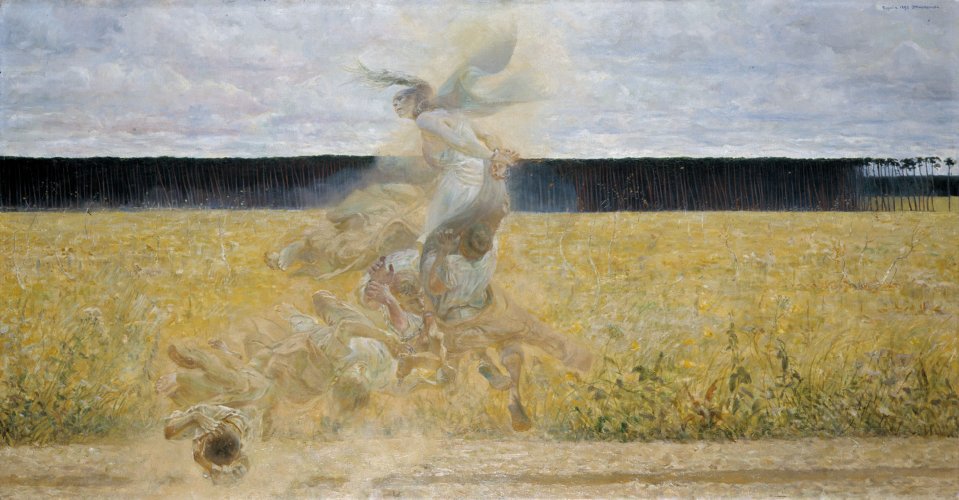Description:
Jack Malczewski (1854-1929) was deeply influenced by his family’s love of art and Romantic literature, particularly the poetry of Juliusz Słowacki. He came from a noble, albeit not wealthy, family. His father, Julian, supported him on his path to becoming a painter. The events of 1863, the January Uprising and subsequent repression, left an indelible mark on the young artist. His first teacher was Adolf Dygasiński. From 1867 to 1871 he spent his youth in his uncle Karczewski’s manor in Wielgie. In 1873 he began studying at the School of Fine Arts in Krakow under the tutelage of Jan Matejko. He was a student of Władysław Łuszczkiewicz. He also studied at the École des Beaux-Arts in Paris. He traveled to Italy, Vienna, Munich, Greece, and Minor Asia. From 1896 to 1900 and 1910 to 1914 he was a professor at the Academy of Fine Arts in Krakow. From 1912 to 1914 he was its rector. He began with an idealizing realism, then naturalism, and his works in this period were particularly focused on the fate of exiles in Siberia and Juliusz Słowacki’s “Anhellim”. At the same time, fantastic and allegorical elements began to appear in Malczewski’s works. After his father’s death in 1884, the recurring theme in Malczewski’s work was Thanatos, the god of death. After 1890, his art became purely symbolic. Works that manifest this turn towards symbolism include “Introduction” (1890), “Melancholy” (1890-1894), and “Vicious Circle” (1895-1897). The artist tackled existential, historical, and artistic themes, intertwining classical and biblical motifs with native folklore and the quintessential Polish landscape. Form, color, monumentality of his representations, and their expressiveness became his trademark.
Description of the Picture:
This painting is regarded as one of the most visionary works of Jacek Malczewski. The melancholic landscape, two colorful strips of golden fields and blue sky are separated by the outline of the Rogalin forest, “the dark wall of the forest visible from the fields of the Podlesie manor, the so–called royal forest“ as Edward Raczyński* describes it. The painting was made during the artist‘s stay at the palace in Rogalin in the autumn of 1893. “In the mist“ probably depicts the fear caused by the plague prevailing in the area. The harvest she reaped decimated the local population. Among the immortalized, swirling figures, one can also see the enslaved Poland and its defenders futilely rising above the dust.
The peacefulness of the landscape is disturbed by a foreground group of whirling figures. The unyielding power and solemnity of nature is pitted against a swarm of history; unbridled, unstable, and uncertain. The boundlessness of the sweeping fields, forests, and sky filled with billowing clouds is contrasted with the cramped, constricted, and helpless whirl of the past, which becomes a burden. The group of figures in motion were interpreted in the context of the ravaging cholera epidemic in Rogalin, the fate of the nation, and the symbolic representation of Polish land. The emerging ghosts of the dead turn to their mother, the enslaved Poland. However, she does not embrace her children. Her hands are bound, and her head is turned to the heavens. The men lying at her feet reach out helplessly to her or hide their faces in their hands. They remain nameless. They are not lifted by the awe–inspiring gust, but are instead helplessly swept up in it. They emerge from the earth, yet are unable to leave it. The whirl cannot carry them to resurrection.
Significant for the interpretation of the work is the title of the painting written on its reverse side by the painter. In popular beliefs and legends, it was usually the devil who appeared in a cloud of sand and dust, and who announced evil. His arrival was a sign of misfortune, in which the travellers he had encountered were plunged. In this context, it is not the painted figures that are the most important, but rather the power that collects its harvest on an empty field and forever connects it with subjugated Poland.


